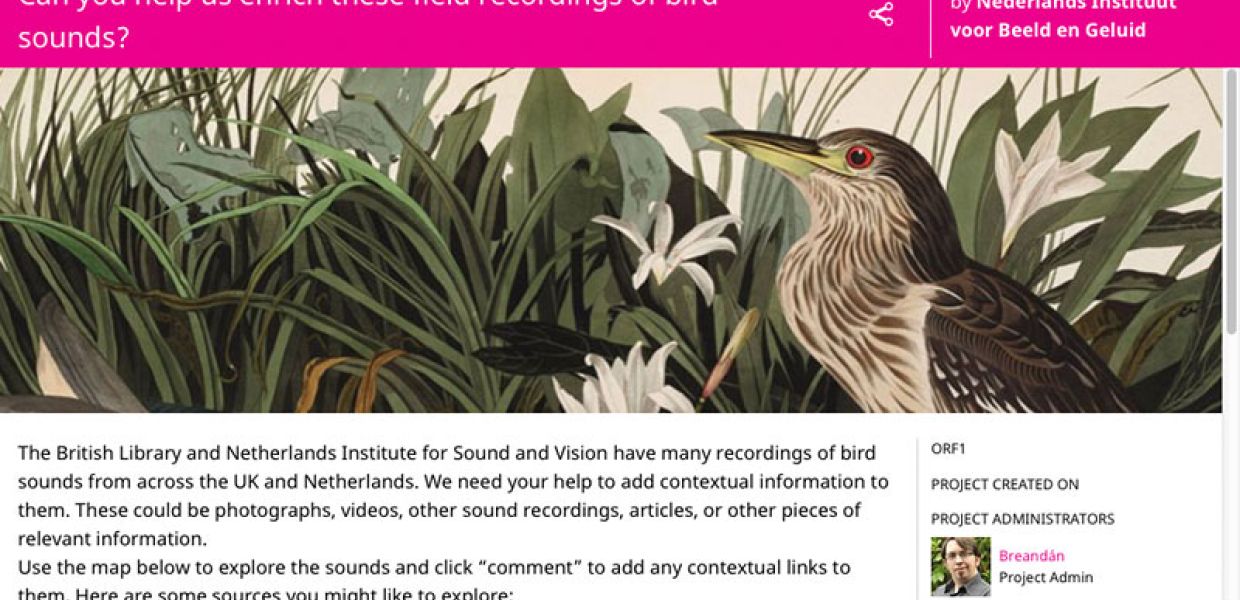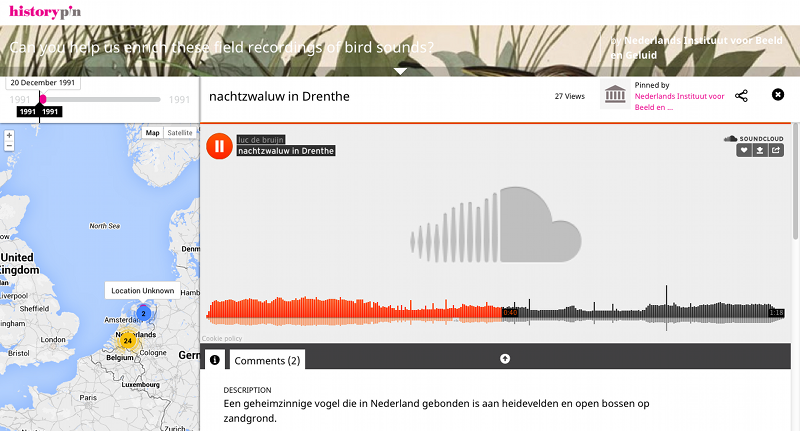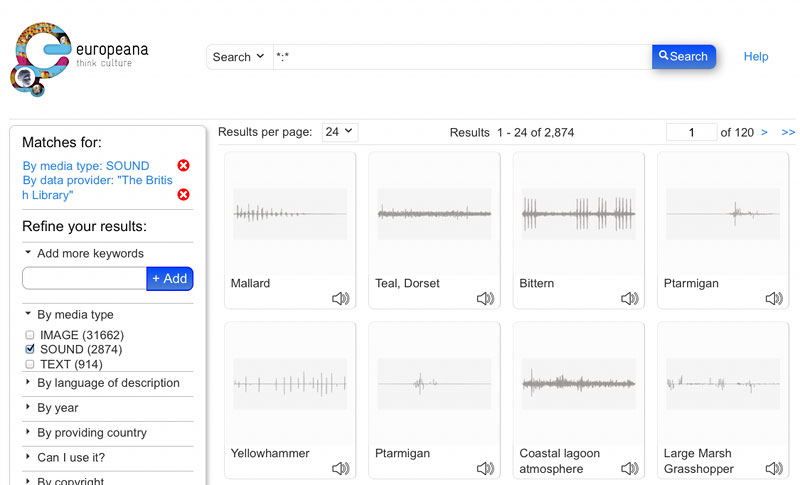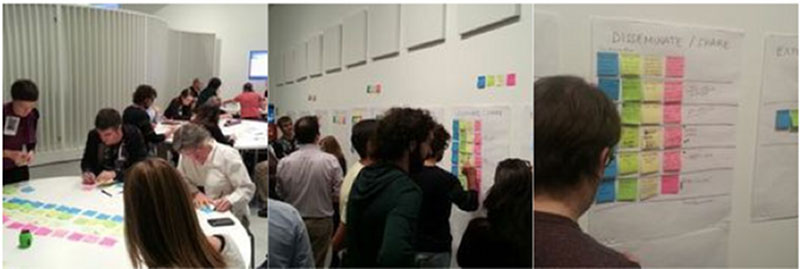Challenging Social Networks with another Europeana Creative Pilot

What if you could easily help to geolocate and enrich sounds from birds, airplanes and city sounds and then share them via social networks? If this sounds interesting to you, keep reading about what we are building and how you can do something similar in order to enter our second round of Europeana Creative Challenges!
Prototype under development
We are building, as another Europeana Creative Pilot, a prototype that uses Historypin’s mapping and timeline tools to allow sounds clips from birds, planes and city soundscapes to be surfaced on a map where they can be explored by location and filtered by time. The user interface facilitates discovery and exploration whilst enabling the enrichment and sharing of Europe’s audio heritage by individuals and online communities.

We Are What We Do, creators of Historypin, have mapped its database to the Europeana Data Model (EDM) so sound records can be ingested from the British Library (BL) and The Netherlands Institute for Sound and Vision (NISV) via the Europeana API into the platform. NISV and the BL have mapped their sound collection datasets to EDM, so that they can be ingested into Europeana and enriched where necessary.
Characteristics
The user interface is being built with mobile in mind and optimised for tablet and desktop computers, so users will be able to use the Pilot on a variety of devices. Users will be invited to explore the sounds via the map and encouraged to enrich them through calls to action in the introductory copy and the comment box.

As we want to facilitate participation and enrichment as well as exploration, we will be incorporating further annotation functionality in future phases of the Pilot. Users will be provided with the ability and add links to other content, adding contextual and experiential value to individual sound files, from sources such as Europeana, Wikipedia and others. We are also planning to allow user generated images and sounds to be uploaded!
Digital content (re)used
The Netherlands Institute for Sound and Vision is using sounds gathered during the Geluid van Nederland (Sound of The Netherlands) project. These sounds come from both the institution’s archive as well as user generated content (UGC). The content is all available and currently hosted on SoundCloud. Almost all the sounds (2,505 items) are available for reuse either under a Creative Commons BY, BY-SA, or BY-NC-ND license.

The audio recordings supplied by the British Library come from a number of different sources. Around 1,000 recordings come from the UK Soundmap project, which are uploaded to Audioboo, and were crowdsourced during the project. The remainder comes from various environmental and wildlife recording collections, including the British Wildlife Recordings (640 recordings) and the A.R. Gregory recordings (around 700 recordings of birdsong from Kenya). Where possible, the content is being made available under the Creative Commons BY licence.
Future work
In the future We Are What We Do will integrate with the Audioboo player. This will enable user commenting, the ability to add links and to do more sophisticated and interesting things with the links e.g. categorise them or show thumbnail images.
So far sample sounds (around 50 for each theme, from both BL and NISV) from each of these collections have been added, and in time we plan to add more to each subtheme. We may also add more subthemes with different sound collections. As we start to share the prototype with communities we will see how people use it and respond accordingly.
What if you take the challenge?
The starting point for this pilot was a co-creation workshop in Palma de Mallorca, facilitated by Platoniq in November 2013. We chose the approach described above for this pilot from a number of different possible scenarios, each combining audio files with other visual elements like pictures and videos from Europeana.
So if you’re a developer or cultural hacker and are also interested in creating new applications and services reusing audio content in order to be shared via social networks, take a look at other potential “what if” scenarios we discussed during our co-creation workshop.

If you like any of our ideas below or they have inspired a new idea of your own we are waiting for you elaborate it further and send us your application for our next Challenges!
-
”What if as a biology teacher I could post to my students' homework folder a collection of recordings and photos of local species for my class to hear and incorporate in their chosen species report”
-
“What if a fan of ancient music I could share online original sounds of old instruments as well as their history, images, extra recordings, etc”
-
“What if as an art lover or museum visitor, I could walk around an exhibition with paintings and listen to the sounds that these paintings might produce (e.g nature, street, conversations), and share my comments & impressions online”
-
"What if as a music lover I could find similar music and explore connections based on its metadata (period, place of performance, tradition, etc) as well as analyze the audio, in order to detect style changes, origins, other similar periods and influences".
-
“What if as a tourist I could upload and download historical audio records or choose them from an interactive platform to build up my own historical touristic experience in a defined location”.
-
“What if as an artist I could transform sounds from a sound archive into images”
-
"What if as a teacher I could assign my students to create an audio mix using sounds of people, places, times, etc and share/present them to tell a story, perhaps with their own narration"
-
“What if as a cultural activist I could record on my mobile and mix on my laptop the sound on a building site near my house with a propaganda speech and make a techno mix to share with my Facebook friends ”
-
“What if as a sound designer / sonic artist I could paint sounds (different colours for different themes) on a canvas and/or transform all sounds in a sound archive into images”
Perhaps you already have a great idea and have favourite sounds or audiovisual materials from Europeana which could be re-used in a creative app? Maybe you have another idea that uses other types of Europeana content such as photographs, illustrations, maps, newspapers, manuscripts or something else? Take a look at all our nice code in Europeana Labs, develop your idea and tell us about it!
